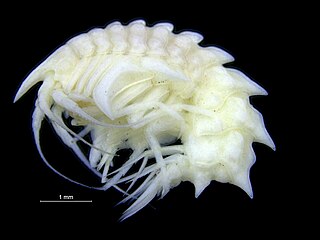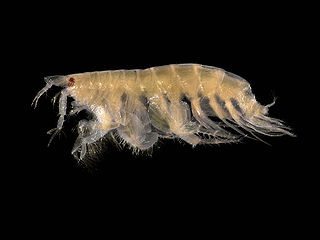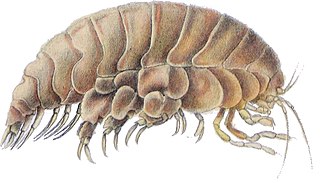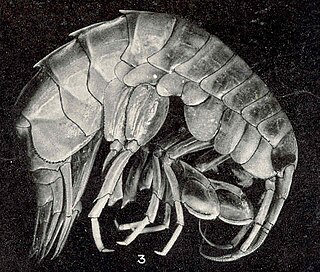
Amphipoda is an order of malacostracan crustaceans with no carapace and generally with laterally compressed bodies. Amphipods range in size from 1 to 340 millimetres and are mostly detritivores or scavengers. There are more than 9,900 amphipod species so far described. They are mostly marine animals, but are found in almost all aquatic environments. Some 1,900 species live in fresh water, and the order also includes the terrestrial sandhoppers such as Talitrus saltator and Arcitalitrus sylvaticus.

Gammaridea is one of the suborders of the order Amphipoda, comprising small, shrimp-like crustaceans. Until recently, in a traditional classification, it encompassed about 7,275 (92%) of the 7,900 species of amphipods described by then, in approximately 1,000 genera, divided among around 125 families. That concept of Gammaridea included almost all freshwater amphipods, while most of the members still were marine.

Epimeriidae is a family of relatively large amphipods found in cold oceans around the world.
Anisogammaridae is a family of small benthic amphipods, endemic to the northern part of the Pacific rim. The family contains the following genera:

The Hyperiidea are a suborder of amphipods, small aquatic crustaceans. Unlike the other suborders of Amphipoda, hyperiids are exclusively marine and do not occur in fresh water. Hyperiids are distinguished by their large eyes and planktonic habitat. Most species of hyperiids are parasites or predators of salps and jellyfish in the plankton, although Themisto gaudichaudii and a few relatives are free-swimming predators of copepods and other small planktonic animals.

Bathyporeia is a genus of amphipods in the family Pontoporeiidae, containing the following species:

Amaryllididae is a family of marine benthic amphipods found throughout the southern hemisphere. These smooth, laterally compressed amphipods can be distinguished by the accessory setal row of the mandible having a distal tuft. It was first described in 2002 by James K. Lowry and Helen E. Stoddart. It contains the following genera:
Curnonidae is a small family of sea slugs, nudibranchs, shell-less marine gastropod molluscs, in the clade Euthyneura.

Alicellidae is a family of amphipod crustaceans, which live as scavengers in the deep sea, often in association with hydrothermal vents. The family includes the following genera:

Themisto is a genus of marine amphipods in the family Hyperiidae. Their distribution is cosmopolitan.

Epimeria is a genus of amphipods in the family Epimeriidae. There are more than 80 described species in Epimeria.

Eurythenes gryllus is a relatively large species of amphipod found worldwide in cold, deep oceans. This widespread and often common species is benthic and lives at depths of 550–7,800 m (1,800–25,600 ft).

Eurythenes plasticus is a species of amphipod of the genus Eurythenes, first described in 2020. It was named in reference to the PET plastic found in its stomach, after researchers wanted to highlight the impact of plastic pollution.
Eurythenes thurstoni is a species of amphipod of the genus Eurythenes. It was first described in 2004 and named after Mike Thurston, a marine biologist specialising in deep-sea amphipods.
Eurythenes obesus is a species of amphipod of the genus Eurythenes. It was first described in 1905 by Édouard Chevreux.

Eusirus is a genus of amphipods belonging to the family Eusiridae. The genus has cosmopolitan distribution. Within the genus Eusirus sexual dimorphism is weak, therefore identifying the sex of non-adult individuals is difficult.

Maera is a genus of amphipod crustacean in the family Maeridae, and was first described by William Elford Leach in 1814. The type taxon is Cancer (Gammarus) grossimanus Montagu, 1808, currently accepted as Maera grossimana.

Eurythenes atacamensis is a species of amphipod restricted to the Peru-Chile ocean trench.

Parawaldeckia is a genus of amphipod crustacean in the family, Lysianassidae. and was first described by Thomas Roscoe Rede Stebbing in 1910. The type species is Parawaldeckia thomsoni.
Amaryllis croca is a species of crustacean in the family Amaryllididae, and was first described in 2002 by James K. Lowry and Helen E. Stoddart.















